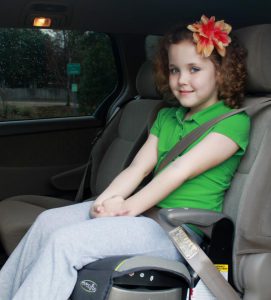If you’re the parent of a “big kid” between the ages of 5 and 12, you’ve probably scratched your head at some point wondering how, where, and in what they should be traveling. There are more options now than ever! Unfortunately, many parents and caregivers make a dangerous choice, without even knowing they could be putting their kids in jeopardy. Following are some of the options for safe travel with older children, including how and why each might work for you:
BELT POSITIONING BOOSTER SEATS
Unlike a car seat, a booster is a positioner, not a child restraint. Its main purpose is to keep the seat belt on the child’s strong hips and collar bone. With a booster, the lap portion of the belt runs under an armrest or clip which holds it low on the hips and upper thighs. This positions the lap belt so that it can’t cut into the child’s soft abdomen, causing serious or potentially life-threatening injuries. Most boosters also position the shoulder belt to keep it flat across the collarbone and protect the neck. An updated study of booster seat effectiveness (Pediatrics, 2009) concluded that children ages 4-8 in boosters are 45% safer from nonfatal injuries than children in seatbelts. The study didn’t find any difference in preventing injury between backless and high-back boosters. Some parents prefer to use high-back boosters because they offer some side-impact protection and give their children a place to lay their heads if they fall asleep. Others prefer the convenience of a lightweight backless booster that can easily travel with the child and be moved between vehicles. A backless booster will NOT work if the vehicle headrest comes below the child’s ears because of the danger of whiplash from rear-end crashes. A child can safely move to a booster seat when he/she has outgrown a car seat by weight and height, as long as the child is mature enough to stay in position while traveling. This usually happens between ages 5-7 but depends on the individual child.
VEHICLE LAP-SHOULDER BELTS
How do you know when your child is ready to “graduate” to an adult seatbelt? Because the height and depth of seats vary from vehicle to vehicle, and all children are not made exactly alike, there is no specific height or weight guideline. Instead, there is a simple 5-step test as follows:
• Is your child sitting all the way back in the seat?
• Do the child’s knees reach the edge of the seat without scooting?
• Do the child’s feet touch the floor?
• Does the shoulder belt cross the child’s collar bone and not his/her neck?
• Is the child mature enough to stay in position during the entire trip?
If you can answer “yes” to every question, your child is ready to use an adult seatbelt in that vehicle. If not, no matter what your child’s age, it might be best to continue using a booster seat for a while. When a child is too small sit in an adult seatbelt, the lap belt will slide up onto his/her stomach. In a crash, the belt will keep tightening because there is no bone or other object (i.e. the armrest of a booster) to stop it. During the crash, everything has to stop so fast that it causes the belt to put extreme force on the internal organs and spine, causing the organs to rupture and the spine to snap or fracture. This cluster of injuries is called “seat belt syndrome” and can be severe. Using a booster until your child is big enough to fit the vehicle seat eliminates the risk.
- Nutrition Misinformation - August 8, 2021
- Belt or Booster? How to Keep Your Big Kid Safe - February 10, 2021
- Sugar vs Honey: What’s the Buzz? - August 17, 2020

